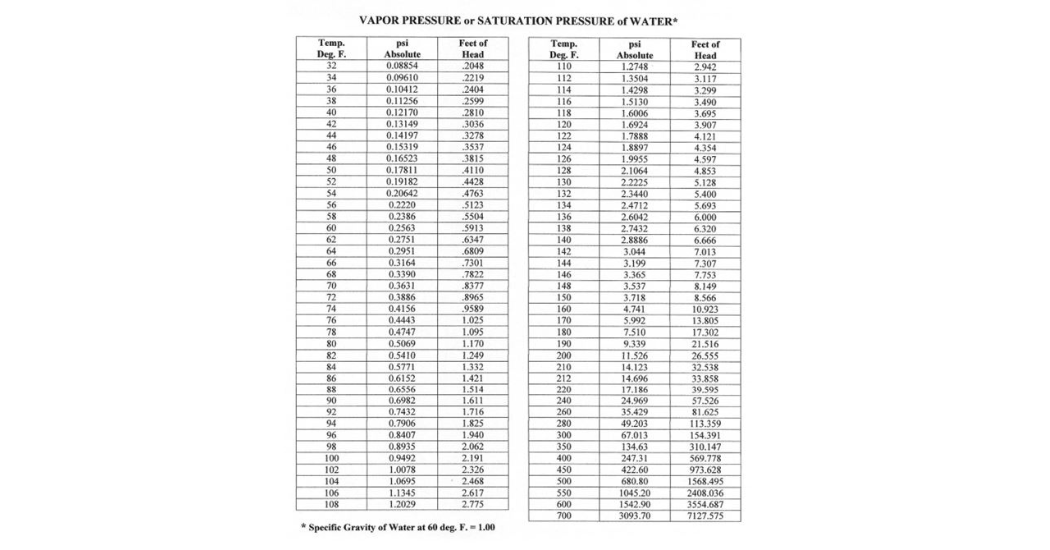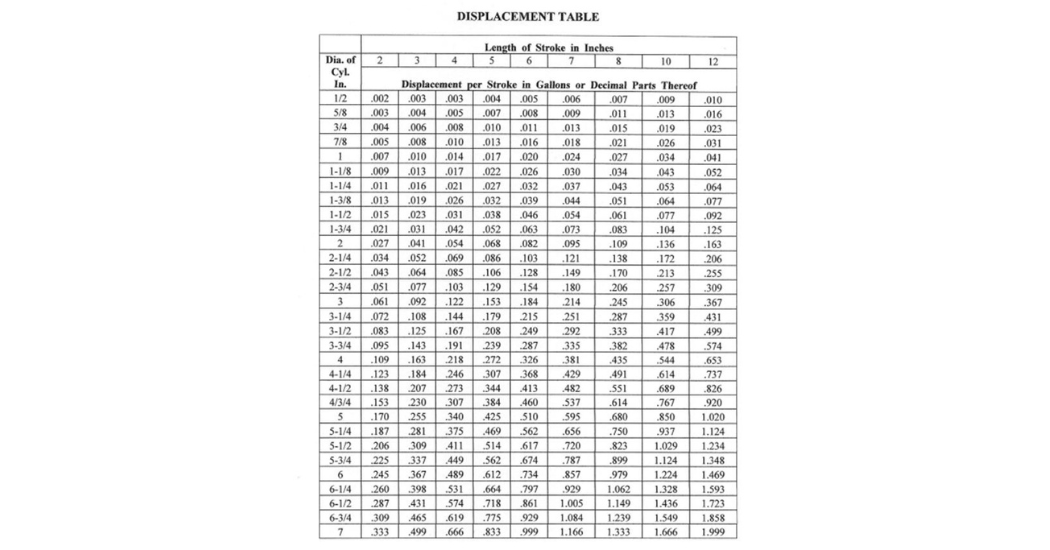Pump cavitation is a phenomenon capable of causing significant disruption to even the sturdiest and resilient pumping systems. Blame is often unfairly cast on the construction of the pump itself. However, most times, cavitation is the result of poor system design, lack of maintenance, and improper understanding of the environmental factors that contribute to pump performance, such as sea level and vapor pressure.
The key to preventing pump damage lies in a sound understanding of a parameter called the net positive suction head (NPSH). To avoid cavitation, the pressure at all points of the fluid must remain above the vapor pressure; in other words, the available net positive suction head (NPSHa) must be sufficiently larger than net positive suction required (NPSHr) at the pump inlet.
The NPSHa is determined by the following formula:
NPSHa = Pa +/- Pg +/- Pz – Pvp – Pf – Pac
Where:
Pa = Atmospheric pressure
Pg = Gauge pressure at the supply tank
Pz = Head or lift pressure
Pvp = Vapor pressure of the liquid at its actual temperature
Pf = Pressure required to overcome friction
Pac = Acceleration pressure
Here, we will look at the various factors that affect the NPSHa value and how they influence cavitation.
Atmospheric Pressure (Pa)
One of the main factors that affects the NPSHa of a pumping system is atmospheric pressure. From the previously mentioned formula, we can see that as the value of atmospheric pressure changes, so too does the value of the NPSHa. Atmospheric pressure is directly related to the elevation above sea level. As the altitude above sea level increases, the atmospheric pressure decreases, thus causing the NPSHa to reduce.
For example, Table 1 shows that at sea level, the atmospheric pressure is 14.7 psi, while at the end of the table, the atmospheric pressure at 7000 feet above sea level is 11.3 psi. It can therefore be seen that pumps installed and calibrated to work at sea level may not have enough NPSHa to function effectively at increased elevations. This fact is especially useful when operating pumps in countries or locations significantly above sea level.
 Table 1: Relationship between sea level altitude and atmospheric pressure
Table 1: Relationship between sea level altitude and atmospheric pressure
Vapor Pressure (Pvp)
Vapor pressure, also known as saturation pressure, is the pressure at which liquid molecules will turn to vapor. The vapor pressure varies depending on the type of liquid and the applied temperature. For example, at atmospheric temperature, water boils at 212°F, causing bubbles to form and steam to rise.
This indicates that the required combination of vapor pressure and temperature has been reached for vaporization to occur. The same water, if placed in an environment with lower atmospheric pressure, will boil at a lower temperature. It can, therefore, be seen that there is a direct correlation between vapor pressure and boiling temperature. As such, one must ensure that the NPSHa is sufficiently above the difference between the pressure at the suction of the pump and the vapor pressure to avoid cavitation.
Based on the NPSHa formula above, we can see that as the vapor pressure increases, the required suction at the head needed to avoid cavitation decreases. Since there is a direct relationship between vapor pressure and temperature, a rise in temperature also results in a reduction in NPSHa.
Table 2 shows the relationship between the boiling temperature (°F) of water and its vapor pressure expressed in both psi and the equivalent head of water in feet. This table confirms that as the temperature of the water increases, so too does the vapor pressure. In the same table, it can be observed that at sea level, water boils at atmospheric pressure (212o F/14.696 psi). Due to this direct correlation, cavitation can be controlled by adjusting other variables, such as the pump speed, if temperature control is not possible.
 Table 2: Relationship between temperature and vapor pressure of water
Table 2: Relationship between temperature and vapor pressure of water
Displacement
Even when taking into account the atmospheric pressure and vapor pressure to lower the NPSHa, other physical adjustments can be made to the pump to achieve optimal performance. Typically, the two most common options for increasing pump efficiency would be reducing the pump speed and adjusting the plunger diameter.
Reciprocating displacement pumps are fixed-volume machines, which means that the volume of liquid displaced at each stroke is constant. However, the rate and discharge pressure of the liquid can be adjusted by changing the size of the plunger and its rate of movement. This can be used to influence the NPSHa directly and, thus, bring the pump closer to its best-operating efficiency.
From Table 3 below, we can see how the plunger diameter and the length of its stroke affect the amount of fluid displaced in gallons. This displacement table is the primary tool to be used when configuring a pump for maximum efficiency.
 Table 3: Relationship between cylinder diameter, stroke length, and fluid displaced per stroke
Table 3: Relationship between cylinder diameter, stroke length, and fluid displaced per stroke
Conclusion
If cavitation is an issue within your pumping system, the engineering team at Triangle Pump Components Inc. can analyze your requirements and pump operating environment to help determine the right components for your needs. We draw on almost a century of experience to provide our customers with the most efficient, dependable, and durable reciprocating pump components for many applications within a variety of environments.
If you would like to learn more about how our components can be used in your reciprocating pump, request a quote and download Triangle Pump’s product catalog today.




